The Hidden Potential of Agroforestry Systems in the Chapare Coca Production Area, Bolivia

Documents CIDOB (Nova època): 4
Tropical regions are the main sources of the fruit, meat and non-forestry timber products that contribute to the state’s food security and sovereignty, enhance producers’ livelihoods and satisfy consumer demand. These tropical regions are rich in natural capital, but the lack of suitable technical, entrepreneurial and financial services impose considerable constraints on the development of these regions. This article shows the opportunities and challenges that producers face. Coca production systems suffer from plagues due to their mono-crop nature and incur high transaction costs from the use of chemicals. Agroforestry systems, on the other hand, are more resilient to shocks from both markets and nature due to their biodiversity and the advantages of the combination of integrated management practices (husbandry, agriculture, grazing).
I. INTRODUCTION
Bolivia has experienced two political periods in the last thirty years. The first, which may be called the neo-liberal, dated from 1985 to 2005 and was characterised by policies such as mineral industry shutdown, re-allocation of human capital, privatisation of basic services and the zero coca programme. This programme introduced the mono-crop culture of banana and pineapples and did not succeed in reducing coca production in the Bolivian producing areas.
In mid-2005 a political shift led to the start of a new social period that continues until the present day and has been characterised by the nationalisation of basic services and fossil fuels, social agricultural policies such as Law no.144 (the “Productive Revolution Law”), as well inclusive policies such as the new constitutional state framework, which defends the domestic consumption and industrialised production of the coca leaf within a political framework.
Nevertheless, coca production at the beginning of this new political context was profitable because of the potential to have three harvests a year, although only with the use of an expensive toxic cocktail which degrades the soil. There is also an invisible coca regulator which restricts over-production through a monitoring procedure led by the state that consists of limiting the size of coca crop areas in the producing zones such as the Yungas and the Chapare.
On the other hand, forestry agroecosystems turned out to be much more profitable than coca crops because of interspecific association of species and resource profitability throughout the whole year. For example, the heart of palm, banana and pineapple crops are being exported to Chile and Argentina, increasing producer incomes.
In this study, I will show that forestry agroecosystems are much more profitable than coca growing in terms of economically-sound business ventures and are more responsible with regard to society and the environment.
1.1 OBJECTIVES
The principal objective is to show that forestry agroecosystems offer an economically sound choice to Bolivian producers in tropical regions.
The specific objectives are:
To compare and analyse the economic benefits of the forestry agroecosystem and coca systems;
To demonstrate the usefulness of the Agroproductive Systems Diagnostic Approach (APDA) for collecting primary data.
2. APPROACH AND METHODS
The objective of the Agroproductive Systems Diagnostic Approach is to study the aspects of the agronomic situation of a region and its transformations in order to identify the ecological, economic and social issues at the moment of the analysis. This analysis is useful for the development of agroproductive plans and strategies for public policies (Dufumier, 1998). It emphasizes interactions between system components at different levels. It moves from the general to the specific, using a holistic method which respects a hierarchy of processes and determinants.
Both quantitative and qualitative approaches were used in this study (Chambers and Mayoux, 2003). The quantitative approach was useful to survey data from the agroforestry systems and the coca system. The collection of primary information was made from January 2012 to November 2012 for the two case studies.
A survey was used in order to collect information on the crops in the systems such as the number of fruit in a tangerine system or the number of leaves in a coca bush. The qualitative approach was useful to collect information from key respondents, using semi-structured interviews and participant observation.
The Agroproductive Systems Diagnostic Approach has four stages. The first is the delimitation of the study which consists of the identification and characterisation of agroecosystems and a history of the production issues. The second is the landscape reading that consists of describing the productive facilities, housing, roads, crops, energy and social network infrastructure. In order to organise these readings, the five livelihood assets were chosen (social, human, physical, financial and natural capital). The third is the characterisation of the productive systems, which is made through planned surveys to measure the production yields and economic inputs and outputs of the production systems. The fourth is the synthesis of the collected data to prepare a briefing.
The methods used for this study were:
Surveys: Five surveys were carried out in order to collect quantitative information from both systems. These surveys were part of the Agroproductive Systems Diagnostic Approach.
Semi-structured interviews: A guide was prepared for each key respondent involved in the two systems. The issues that were developed in this guide were: crop seasons, agricultural practices, yields and commercialisation. A total of sixteen interviews (n=16) were conducted, eight for each system (n=8). The interviewed subjects were producers, technicians and transporters.
Participant observation: The observation was made from the inside. This means that I interacted and shared knowledge and experiences with producers and technicians in the fields.
3. RESULTS
3.1. Delimitation of the study area
Two study areas were selected. The first was the agroforestry system of the Valle del Sacta which is composed of secondary forest, cattle (buffalo and caprines), tropical fruits (tangerine, cupuaçu, cacao, banana, plantain, camu camu, annona, maracuya), and grazing species. The second was the coca leaves agroecosystem.

This study was made at the Valle del Sacta University Unit which is located at km 244 on the Cochabamba to Santa Cruz road. The climate is tropical humid with an average rainfall of 2300mm per year, an average temperature of 25°C per year and an altitude of 220 masl (metres above sea level).
3.1.1 Forestry agroecosystem
The forestry agroecosystem consists of cupuaçu trees, Arachis spp, other fruits such as banana and plantain, ornamental flowers such as Bromelia spp, and bovines and caprines adapted for tropical regions as shown in the sketch made by IMA alumni (Illustration 2)
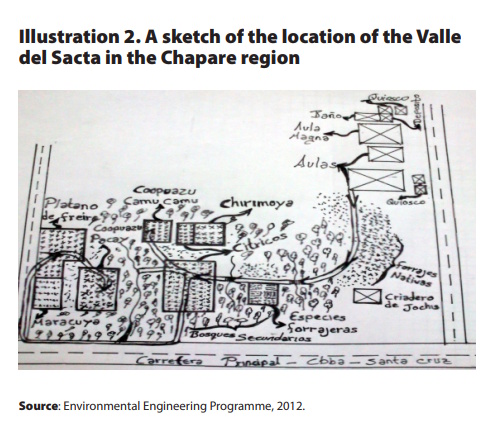
Citric fruits: The citric fruits are oranges (Citrus sp) and tangerines (Citrus reticulata) in an area of one hectare where there are seven thousand trees. In the case of the oranges, we used five sampling techniques in order to quantify the number of fruit per tree and we found that the mean for the samplings is 42.4 fruit. Doing some calculations we found that the overall yield is 296,800 fruit in the area. Figure 1 shows the prices for this product during 2012.
Cupuaçu: The cupuaçu is from the Theobroma sp family and each bush of 1.60m produces at least 10-15 kernels. Each kernel weighs around 2-3kg. The average yield per 6.5kg of kernel is 2.5kg of pulp which costs between $2.91 and $3.65 at final gate price in Cochabamba city. For this study, the cupuaçu area was 0.4 hectares and the number of fruit per bush was 9 (average). The number of bushes in the sample was 40. So the average yield was 360 cupuaçu fruit and the calculated yield in kilos was 1620kg in that area, which provides a net 1070kg once the pulp is extracted. At farm gate prices this means an income of $3,510 per year. The cupuaçu requires whole-year management; the harvest period was from March to July.
Plantain (Musa sp): The area covered by plantain was 1 hectare. The average yield per plantain plant was 77 units. The number of plants was 1120 units. Therefore the number of plantains was 86,240 plantains grouped in 1120 heads. The price of each head at farm gate is around $1.45 to 2.18. The calculated income was $2,033.
Livestock: The Valle del Sacta campus has 228 livestock. The majority are buffalo, equines and caprines. For this study, we considered the cattle, due to the milking industry which is being developed in an area of 25 hectares. A total of 64 cattle were found and an average of 40 are milking. Each producing cow has an average yield of 6 litres a day due to the fact that milking is done once a day on the campus. The average price for 1 litre of milk is $0.52/litre, meaning an income of $45,552 was received in 2012. Once the costs involved in each sub-system were defined, we calculated the income and outcome relation which is summarised below.
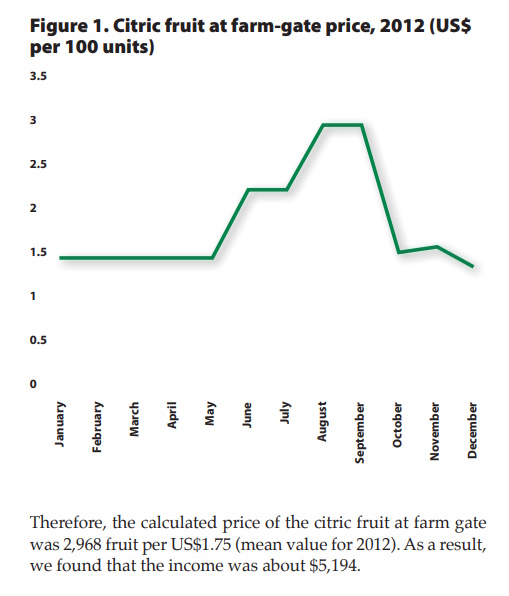
4.1.2 Coca crop
The coca crop was located at Valle del Sacta, Copacabana Sindicate at 220 masl. This crop was located 5km from the Cochabamba-Santa Cruz roadway and was surrounded by other mono-crops such as maracuya and tangerines.. In this study case the coca crop was located at a distance of 800m, through a difficult access, as shown in the photograph.

The coca crop yield per hectare is between 10 and 12 quintals,1 representing at least $1459-1751 every three months to the producer. But in order to prepare the terrain and the coca plants once their leaves have been trimmed for the next harvest, producers must wait for a month twice a year in order to harvest a new leaf production. In summary, coca producers have two harvests a year that represent $3503 a year per hectare in terms of earnings but they spend $1021 a year, meaning net earnings of $2482 per hectare.
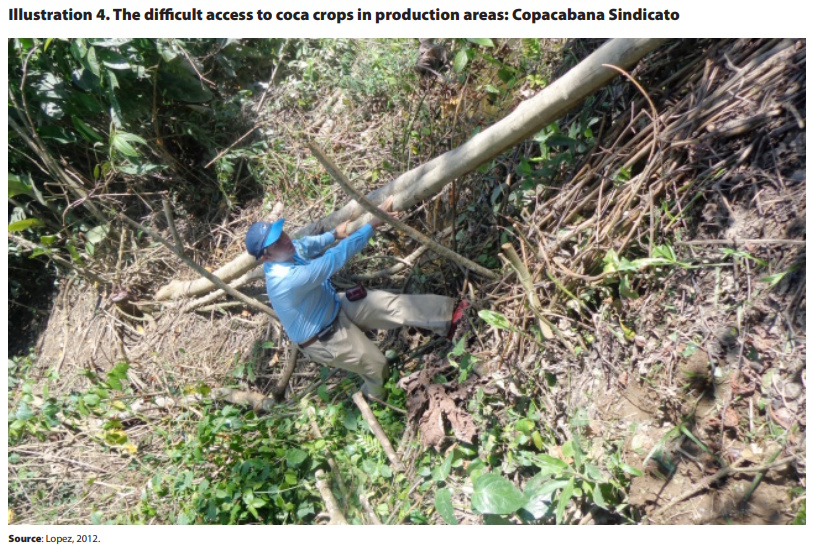
In our study, we considered a 1.5 hectare coca area which was located in the Sama District (20km from the Sacta research centre) accessed via a muddy road from the main Santa Cruz and Cochabamba road. The coca yield was 18 quintals for the first season and 15 quintals for the second season, representing an overall yield of 33 quintals per year.
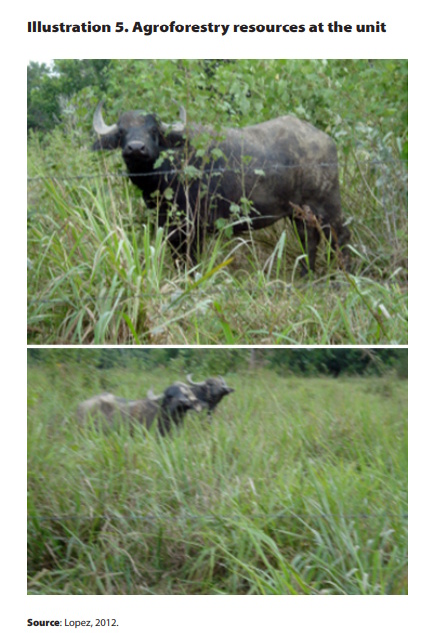
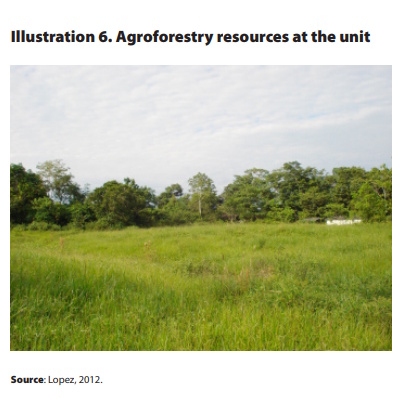
3.2 LANDSCAPE READING
Natural capital: The crops were classified as pastures and fruit; the animal husbandry was classified into major animals (buffalo) and minor animals (sheep, jochies and goats). The buffalo is the most common animal (n=100 animals). At least 80 of this population are for milking and 20% are in the growth stage. The land has an area of 25 hectares. The principal crops are: cupuaçu (0.4 ha), tangerine (1.5 ha), plantain (1 ha), camu camu (0.3 ha), annona (0.6 ha), cacao (2.5 ha), pastures (17 ha), banana (3.3 ha), maracuya (1.5 ha), pacay (0.8 ha) and secondary forest (4.5 ha).
Physical capital: This capital is made up of the transportation system such as roadways, pathways, the electrical grid and communication facilities.
Social capital: The social capital is coordinated by the local banana and plantain cooperative, called UNABANA (n=100 associates).
Financial capital: This capital is composed of the economic activities and the commercialisation of produce from both systems. The coca system generates 40 quintals2 of coca leaves creating an annual income of $3,407 in an area of 1.5 hectares (Table 1). A cost-profit analysis was done in order to compare both agroproductive systems.

Human capital: In this study the human capital considered was the mass of students involved in the 2012 Tropical Agriculture and Environmental Engineering Programme at the Universidad Mayor de San Simon from the fourth (n=10) and the sixth semester (n=6), respectively.
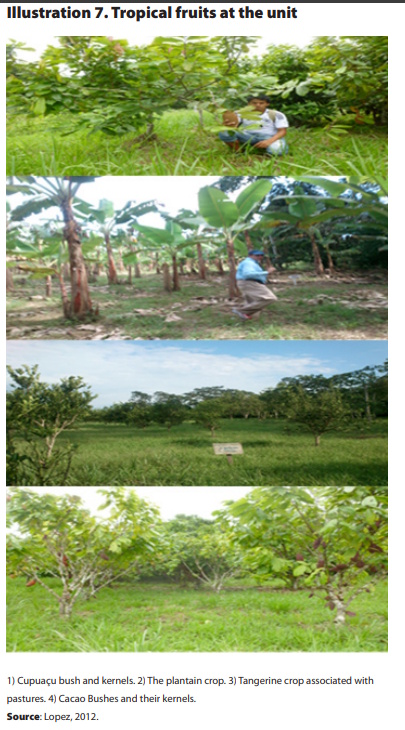
According to the survey, the data showed that cattle provides the best income for the agroforestry system (Table 2). The net income is about $51,015. The outputs considered were: field labour, vaccination, harvest, transportation.

Human capital: In this study the human capital considered was the mass of students involved in the 2012 Tropical Agriculture and Environmental Engineering Programme at the Universidad Mayor de San Simon from the fourth (n=10) and the sixth semester (n=6), respectively. Comparing both systems (agroforestry system vs. coca crop) The coca system presented a low value for natural capital due to its mono-crop nature. The economic capital value is also low due to the higher investment in chemicals for pests. On the other hand, the human, physical and social capital values are higher due the organisation and specialisation of coca growers. The agroforestry system has taken the pentagon-shaped form which is the most appropriate for a solid livelihood strategy that could be adopted by small farmers in the Chapare area.
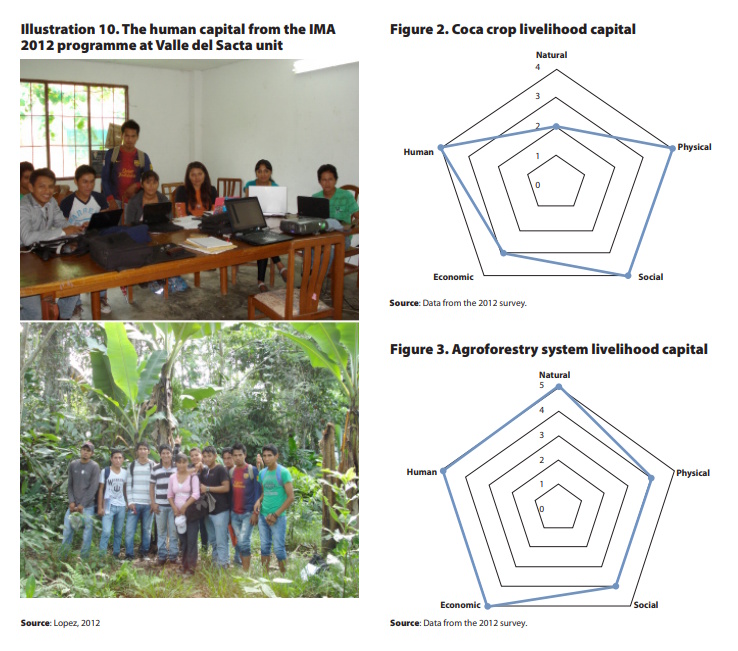
CONCLUSIONS AND RECOMMENDATIONS
In spite of the attractive economic profits for growing coca in this region, the huge supply of coca tends to disincentivise producers due to competition, which reduces net incomes for producers. The control and monitoring of coca production schemes is helping to reduce the number of hectares of coca leaves grown annually.
The forestry agroecosystems permitted an increase in the producer’s income of at least 20% when compared to the coca crop.
The forestry agroecosystems allowed the producer to harvest at least five times during the period of the study rather than the four harvests for coca crops during the same period.
According to the analysis of the collected data, the cost-benefit analysis of the agroforestry system is at least 20% higher than the coca crop.
The agroforestry system showed that the inputs used (agricultural practices, agrochemicals) were 45% lower than for the coca crop that used the most.
The Agroproductive Systems Diagnostic Approach (APDA) is a useful technique that allows us to evaluate the livelihood capitals of a productive system faster than other approaches such as Participatory Rapid Appraisal (PRA).
It is well-known that agroforestry systems are much more reliable and resilient than coca crop systems due to the variety of the species. For example, fruit in this system provides incomes throughout the year and native pastures provide grazing for cattle
The coca crop system uses many more chemical products than the agroforestry system due to its mono-crop nature, as was evidenced in the field by the fact that plagues affect it more than the agroforestry system species.
We found that most of the coca crop systems in the region are located in the middle of agroforestry systems and entering them is quite difficult due the tight social control exerted (Garcia-Yi, 2010). At least 80% of the producers interviewed agreed that coca leaf production is a livelihood strategy to gather financial capital to start other activities such as pineapple and banana crops for export but they say that “coca crops need more chemicals to produce, erode soils and are subject to plague attacks”.
We refute the findings of Davalos et al (2008) stating that the farm income of a coca-growing farmer is about 54% higher than the income of a non-coca-producing farmer which is not a conclusion it is possible to reach from our study.
RECOMMENDATIONS
Research centres such as the INIAF2 should incentivise the agroforestry systems experience due to its benefits for potential producers in tropical areas.
Policy makers should support transformation in producing agroforestry systems areas as well as coca leaf production. For example, gathering centres for transportation and processing are needed in the area.
Transaction cost estimation is needed for the quantification of the costs involved in both productive systems in order to provide an accurate cost assessment for further research.
A value chain analysis is needed in order to identify the actors involved (producers, processors, distributors/transporters, consumers), market opportunities and limitations for producers of exotic tropical fruits such as cupuaçu (which is experiencing a huge growth in demand in Cochabamba city), cacao and others.
Future professionals such as those emerging from the Environmental Engineering (IMA) and the Tropical Agriculture Engineering (CATREN) programmes and those run by the Universidades Campesinos (Peasant Universities) must be encouraged through technical and financial support for them and their endeavours in order to increase production and satisfy the exponential demand for tropical fruit as commercial activities.
It would be useful to create a market intelligence centre in order to provide accurate market information to producers, processors and consumers involved in the chains.
In summary, we must provide technical, entrepreneurial and financial services through public and private service providers.
Notes:
1- quintal is equal to a 50kg sack.
2- Instituto Nacional de Innovación Agropecuaria y Forestal (National Agroforestry Research Institute)
Key words: agroforestry systems, coca, tropical fruit, Agroproductive Systems Diagnostic Approach
E-ISSN: 2339-9570 / D.L.: B 11.000-2014